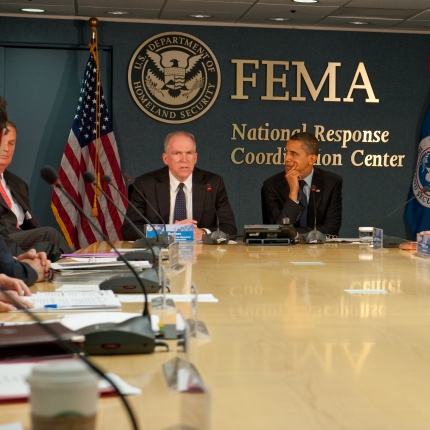 Deficient insurance review processes used by the Federal Emergency Management Agency (FEMA) resulted in the agency overfunding its Fiscal Year 2004-2005 Florida hurricane grants by more than $177 million, leaving the government liable for an estimated $1 billion in future disaster costs, according to a new audit by the Department of Homeland Security Inspector General (IG).
Deficient insurance review processes used by the Federal Emergency Management Agency (FEMA) resulted in the agency overfunding its Fiscal Year 2004-2005 Florida hurricane grants by more than $177 million, leaving the government liable for an estimated $1 billion in future disaster costs, according to a new audit by the Department of Homeland Security Inspector General (IG).
According to the IG, the report, FEMA Insurance Reviews of Applicants Receiving Public Assistance Grant Funds for 2004 and 2005 Florida Hurricanes Were Not Adequate, “was initiated as a follow-up to previous audits and in response to two OIG hotline complaints. The IG sought to determine whether FEMA followed proper procedures in making grants to Florida property owners for damages suffered in seven hurricanes and two tropical storms in 2004 and 2005.
“The first complaint, received in January 2011, identified concerns with duplication of benefits and damages that insurance should have covered in the state of Florida,” the IG’s audit report said. The second complaint, received in February 2011, indicated that, since 2010, FEMA management had been aware of potentially significant issues with insurance adjustments relating to disaster assistance in 2004 and 2005. In addition, our three previous audits of Florida grant recipients raised similar concerns.
The audit revealed that:
- FEMA’s insurance reviews were inadequate to ensure that approved costs included required reductions for the recipients’ private insurance coverage. As a result, FEMA may have overpaid for repairs that should have been covered by private insurance;
- Insurance specialists routinely waived a requirement that FEMA aid recipients obtain and maintain insurance coverage for future disasters, even though they did not have the authority to take such action, and such action could cost FEMA and the taxpayers millions in future liabilities; and
- The conditions we found could lead to significant duplication of benefits and added costs to the government in future disasters.
“FEMA officials must assure that aid recipients’ private insurers bear their share of disaster losses before they approve the use of Federal funds,” said Inspector General John Roth. “And it is unconscionable that those officials would also leave the taxpayers liable for future losses by defying policy and ignoring the requirement that recipients obtain insurance coverage for future storms.”
“The quality of FEMA’s insurance reviews in Florida was not adequate to maximize insurance available under applicants’ policies and to ensure that duplication of benefits did not occur,” the IG’s audit concluded, adding, “FEMA’s Florida Recovery Office knew about these deficiencies in its insurance review process but did not correct them. As a result, FEMA may have funded up to $177 million that insurance should have covered.”
“Furthermore,” the IG audit stated, “FEMA’s insurance specialists routinely waived the requirement to obtain and maintain insurance for future disasters, even though they did not have the authority to take such action. FEMA’s Florida Recovery Office did not detect and correct this deficiency. As a result, FEMA potentially stands to lose up to a billion dollars in future Florida disasters because many Florida communities may not have adequate insurance coverage for future disasters such as those that occurred in 2004 and 2005.”
The IG stated, “In some cases, the specialists determined that insurance was not available, even when the applicant had a policy covering the damaged facilities. Of the 78 project worksheets we reviewed, 38 (49 percent) included a comment that no insurance was available or that insurance did not cover the damages.”
However, the IG said its “review showed that FEMA insurance specialists adequately supported only 4 of their 38 ‘no insurance’ decisions; FEMA expects these 4 projects to total $662,085. As for the remaining 34 projects totaling $11.1 million, FEMA insurance specialists either incorrectly arrived at that decision, or could not support that decision. Specifically, FEMA insurance specialists incorrectly arrived at a no-insurance determination for 23 projects totaling $8.6 million, and had no support to justify their determinations for 11 projects totaling $2.5 million.”
FEMA said it was withholding comments until after the IG issued its final report. FEMA’s written response is due within 90 days of issuance of the report, the IG said.
The audit comes on the heels of another audit by the DHS’s Inspector General which found FEMA’s failure to track $66 billion in obligated disaster funds put long-term disaster recovery efforts at risk. And an audit the Government Accountability Office (GAO) that identified $39 million, or 2.7 percent, of Hurricane Sandy financial assistance may have been improper or outright fraudulent compared to 10–22 percent of similar assistance provided for Hurricanes Katrina and Rita.
Homeland Security Today reported in October that another DHS IG audit found significant flaws in FEMA’s $247 million disaster relief system that may hamper an effective response to a catastrophic disaster.
In July, Homeland Security Today reported that 58 management and disaster relief fund audit reports by DHS’s Inspector General identified $88.6 million in questioned costs, and $8.9 million in funds that could be put to better use.
For example, an OIG audit found FEMA officials did not correctly apply their own disaster relief guidelinesin response to the catastrophic 2008 flooding in Cedar Rapids, Iowa, resulting in a loss to taxpayers of more than $12 million.
Furthermore, a 73-page GAO audit released in December disclosed that 13 percent, or $12.7 billion, of the $95.2 billion obligated from FEMA’s Disaster Relief Fund (DRF) for the 650 major disasters declared from Fiscal Years 2004 through 2013 went to pay for administrative costs.
During this same period, 32 percent more major disasters received obligations from the DRF than in the preceding fiscal years.
Source: HS Today




